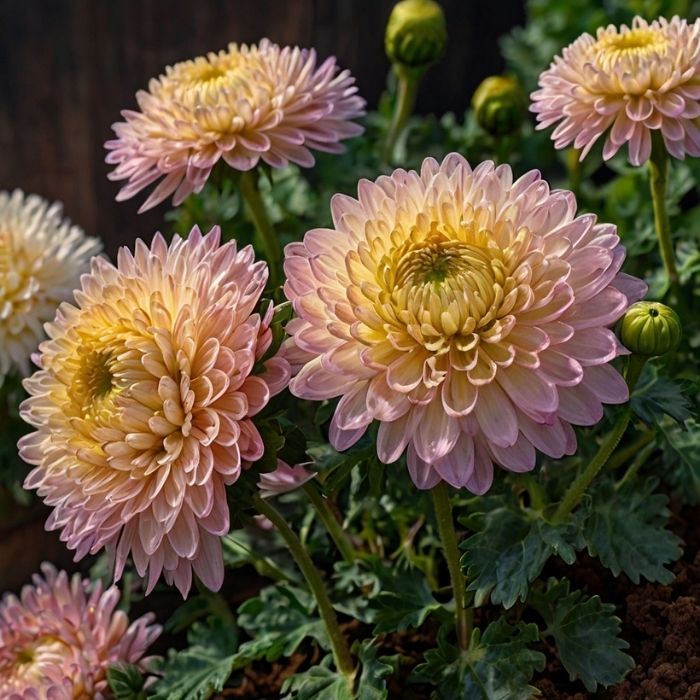How to Grow Chrysanthemums from Seeds: A Comprehensive Guide
Chrysanthemums, often referred to as “mums,” are beloved for their vibrant colors, diverse shapes, and long-lasting blooms. These hardy perennials are a staple in gardens, adding a splash of color in late summer and fall. While many gardeners propagate chrysanthemums through cuttings or division, growing them from seeds can be a rewarding experience. Not only does it allow you to explore a wider variety of species, but it also gives you the satisfaction of nurturing a plant from its very beginning. In this guide, we’ll walk you through everything you need to know about grow chrysanthemums from seeds
Why Grow Chrysanthemums from Seeds?
Growing chrysanthemums from seeds offers several advantages:
- Variety: Seed catalogs often offer a broader range of chrysanthemum varieties than what’s available at local nurseries.
- Cost-Effective: Seeds are generally more affordable than buying mature plants.
- Satisfaction: There’s a unique sense of accomplishment in growing a plant from seed to bloom.
- Customization: You can experiment with different colors, sizes, and bloom types to create a garden that’s uniquely yours.
Choosing the Right Chrysanthemum Seeds
Before you start, it’s important to select the right seeds for your garden. Chrysanthemums come in a wide range of types, including:
- Single Blooms: Daisy-like flowers with a central disc and radiating petals.
- Pompons: Small, globe-shaped flowers.
- Spiders: Long, tubular petals that resemble spider legs.
- Anemones: Central cushion-like blooms surrounded by flat petals.
- Decorative: Large, showy flowers with layered petals.
When choosing seeds, consider factors like your climate, the size of your garden, and the desired bloom time. Look for reputable seed suppliers to ensure high-quality, non-GMO seeds.
When to Start Chrysanthemum Seeds
Chrysanthemums are typically grown as perennials in USDA hardiness zones 5-9. If you’re starting from seeds, timing is crucial. Here’s a general timeline:
- Indoor Sowing: Start seeds indoors 6-8 weeks before the last expected frost date in your area. This gives the seedlings enough time to establish before transplanting outdoors.
- Outdoor Sowing: If you live in a warmer climate, you can sow seeds directly in the garden after the danger of frost has passed.
Step-by-Step Guide to Growing Chrysanthemums from Seeds
1. Gather Your Supplies
To get started, you’ll need:
- Chrysanthemum seeds
- Seed-starting trays or small pots
- High-quality seed-starting mix
- A spray bottle for watering
- Grow lights or a sunny windowsill
- Plastic wrap or a humidity dome (optional)
2. Prepare the Seed-Starting Mix
Fill your seed trays or pots with a well-draining seed-starting mix. Chrysanthemum seeds require light to germinate, so avoid covering them with too much soil. Lightly press the seeds into the surface of the soil, ensuring good contact.
3. Sow the Seeds
Sprinkle the seeds evenly over the soil surface. Since chrysanthemum seeds are tiny, you can mix them with a bit of sand to help distribute them more evenly. Gently press them into the soil without burying them.
4. Provide Optimal Conditions
- Moisture: Use a spray bottle to mist the soil lightly. Keep the soil consistently moist but not waterlogged.
- Light: Place the trays in a bright location or under grow lights. Chrysanthemum seeds need light to germinate, so avoid dark areas.
- Temperature: Maintain a temperature of 70-75°F (21-24°C) for optimal germination.
5. Monitor Germination
Chrysanthemum seeds typically germinate within 10-15 days. Once the seedlings emerge, remove any plastic coverings and ensure they receive plenty of light. If using grow lights, keep them on for 12-16 hours a day.
6. Transplant Seedlings
When the seedlings have developed 2-3 sets of true leaves, they’re ready to be transplanted into larger pots or directly into the garden. Harden off the seedlings by gradually exposing them to outdoor conditions over 7-10 days.
7. Plant in the Garden
Choose a sunny location with well-draining soil. Space the plants 18-24 inches apart to allow for proper air circulation. Dig a hole slightly larger than the root ball, place the seedling in the hole, and backfill with soil. Water thoroughly.
Caring for Your Chrysanthemums
Once your chrysanthemums are established, they require minimal care to thrive:
- Watering: Keep the soil evenly moist, especially during dry spells. Avoid overhead watering to prevent fungal diseases.
- Fertilizing: Apply a balanced fertilizer every 4-6 weeks during the growing season.
- Pinching: To encourage bushier growth and more blooms, pinch back the tips of the stems when they reach 6 inches in height. Repeat this process every 2-3 weeks until mid-summer.
- Mulching: Apply a layer of mulch around the base of the plants to retain moisture and regulate soil temperature.
- Pest Control: Watch for common pests like aphids and spider mites. Treat infestations promptly with insecticidal soap or neem oil.
Common Challenges and Solutions
1. Poor Germination
If your seeds fail to germinate, it could be due to old seeds, improper light, or incorrect temperature. Always use fresh seeds from a reliable source and follow the recommended growing conditions.
2. Leggy Seedlings
Leggy seedlings are often a result of insufficient light. Ensure your seedlings receive adequate light by placing them under grow lights or in a sunny window.
3. Fungal Diseases
Overwatering or poor air circulation can lead to fungal diseases like powdery mildew. Water at the base of the plants and space them properly to improve airflow.
Harvesting and Enjoying Your Chrysanthemums
Chrysanthemums make excellent cut flowers and can brighten up any indoor space. To harvest, cut the stems early in the morning when the blooms are fully open. Place them in a vase with fresh water and floral preservative to extend their lifespan.
Final Thoughts
Growing chrysanthemums from seeds is a fulfilling endeavor that allows you to explore the incredible diversity of this beloved flower. With patience, care, and attention to detail, you can enjoy a stunning display of blooms that will brighten your garden year after year. Whether you’re a seasoned gardener or a beginner, this guide provides all the information you need to successfully grow chrysanthemums from seeds. Happy gardening!

